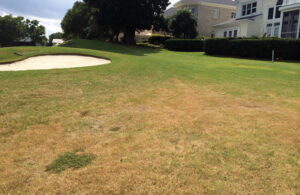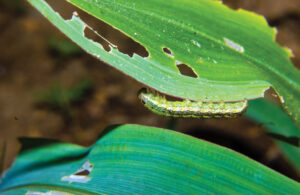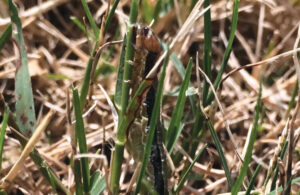Industry experts share tips to avoid a fall armyworm ambush
Industry experts share why it's important to be vigilant when it comes to fall armyworm.
The post Industry experts share tips to avoid a fall armyworm ambush first appeared on Golfdom.

Before damage appears superintendents can look for birds feeing on fall armyworms in their turf as an early warning sign. (Photo: Lane Tredway)
While researchers may not be able to predict another fall armyworm apocalypse like the northern U.S. saw in 2021, Blake Layton, Ph.D., Extension entomology specialist at Mississippi State University, says golf course superintendents should always be prepared for every possibility.

Blake Layton, Ph.D.
“(Fall armyworms) are a sporadic pest that you need to be ready for every year. Some years they’re going to be worse than others, and you’ll have those odd years that are going to be really bad,” he says. “Be aware of them. Don’t let them catch you by surprise and be prepared to treat and know what you need to treat with.”
Luckily for golf course superintendents who remain vigilant, fall armyworms can be quick and easy to control. Layton does add, however, that prevention can be a difficult task if a superintendent doesn’t apply early enough.
For the best defense against this turf-destroying pest, Layton says superintendents should consult their local Extension office to get a scouting report on what the outbreak in a given year might be.
When to look?
For golf course superintendents in the northern half of the U.S., fall armyworms usually start to pop up around July or August. That’s relatively the same for supers in the south, with rare exceptions in the deep south, Layton says.
“We can have treatable populations in June down here in Mississippi, but usually for us, it’s July, August and September,” he explains

Photo: Lane Tredway

Brian Mount, M.S., B.C.E.
FMC
Brian Mount, M.S., B.C.E.
Technical Service Manager
If a golf course has a history of fall armyworm outbreaks, then preventative applications can be made as early as April with products such as Durentis insecticide (chlorantraniliprole) for season-long control at very low rates. Depending on where you are geographically scouting for moths as early as May will help predict an outbreak. Again, using black light or pheromone traps can help with monitoring for adults. Larvae typically are first seen in late June/July (depending on location) and will feed for a couple of weeks, pupate, and start another generation.
If fall armyworms are actively feeding on the turf (three to four armyworms per square foot — or where excessive damage is observed) an application of a pyrethroid such as bifenthrin will knock the population down but may need to be reapplied for longer-term control. An application of Durentis can be made when adults first appear to ensure long-term protection of the turf.

Bobby Kerr, Ph.D.
Quali-Pro
Bobby Kerr, Ph.D.
Technical Services Manager
Fall armyworms are a challenging pest in turfgrass systems in the U.S. Preventively, fall armyworms can be controlled with a timely application of chlorantraniliprole or another insecticide in the diamide class of chemistry.
Typically, turf managers make timely grub control applications. In previous years, during outbreaks of fall armyworms, the grub application has proved effective. Depending on your geographical location, armyworms can complete a different number of life cycles. For example, in Louisiana, four life cycles can be completed in a year compared to New York where only one life cycle occurs.
This is really an important point for turfgrass managers when looking at preventative applications. I once asked a group of superintendents what approach they took to fall armyworm control. The response was, “Wait until they’re waving at me.” Well, if they’re waving at you, control becomes challenging. Any contact insecticide would be an option. The pyrethroid class of chemistry is a good option, for curative applications Bifenthrin I/T can be applied at 0.18 to 0.25 fl. oz./1000 sq. ft.

Photo: Lane Tredway
Nufarm
Rick Fletcher
Technical Services Manager

Rick Fletcher
Fall armyworm management starts with understanding its life cycle. This insect only successfully overwinters as an adult in the southern United States and Mexico. It has an annual northern migration pattern that is highly influenced by weather, with winds aiding the nightly flights of adults. Armyworms typically have a single generation per year in the U.S. which can aid their management when using proper preventative and curative treatments.
The treatments will vary geographically from south to north based on insect movement and the continuation of the life cycle to the damaging larval stage. After egg-hatch, fall armyworm larvae quickly complete 5-6 growth stages and can reach maturity in as little as 2 to 3 weeks, feeding heavily on healthy turf. Preventive treatment must have longevity to be effective during the larval activity. Curative treatment should be applied early in the larval development to minimize turf damage.
Syngenta
Lane Tredway, Ph.D.
Technical Representative

Lane Tredway
It’s impossible to predict if or when armyworms will appear in your area during their annual migration northward from overwintering sites down south. Scouting can help to detect their presence before they cause significant damage. Adult moths lay yellowish-white egg masses on vertical surfaces adjacent to susceptible turf, such as flag sticks, fence posts, tee markers, or ball washers. The eggs hatch in a few days to a week, and the tiny caterpillars drop down onto the turf to begin feeding and growing into large, grass-eating machines over 2-3 weeks. Fall armyworm outbreaks progress quickly, so prevention is the best strategy. Most insecticides provide 2-4 weeks of protection, but Acelepryn (chlorantraniliprole) and Acelepryn Xtra (chlorantraniliprole and thiamethoxam) insecticides can provide longer-term protection against armyworms. When applied in May or June to control grubs and billbugs, its residual activity in the plant and soil prevents fall armyworm for up to 4 months. In most areas, this means supers can achieve season-long prevention of all three with one application.
The post Industry experts share tips to avoid a fall armyworm ambush first appeared on Golfdom.
